When you start shopping for a snowboard there are two major areas that you will need to understand to make sure you are getting the right board. First, is information about you. Second, is information about the board. Under those two areas there are many little subheads which we will discuss. There is a lot of information so we have split this article into two parts. If there is jargon used that you don’t understand right away, just hold tight, it will all be explained.
Information About You
In determining what types of board you should be looking at you will need to know your skill level, your riding style, your boot size, how much you weigh and how tall you are. This information will help you to determine the length, shape, flex and width of your board.
Experience Level
There are three skill levels of riding; beginner, intermediate, and expert. A beginner is someone who has never been snowboarding before or someone who is still slowly feeling their way down a run. An intermediate rider is going to be more solid on their feet, comfortable riding toe and heel edges, maybe starting to ride switch, and possibly starting to ride a little park or advance their riding is other ways. An expert rider has a sound confidence having a board strapped to their feet. They are able to adapt to elements and conditions as they come upon them and can ride the steepest terrain under control. Pro sometimes might be considered a level, and these kids, let’s just say they are more comfortable on a snowboard than they are walking on their own two feet because they ride more than walk. It is important to know your experience level when buying a board, especially as a beginner, because many boards will be made specifically for riders at each level.
It is important to know your experience level when buying a board because many boards will be made specifically for riders at each level. You also will want to plan ahead so that as your riding progresses you won’t out grow your board too quickly. If you’re looking at boards online there will generally be a description to go along with it. What skill level the board was intended for will be specified in this explanation.
Riding Style
What type of riding you intend to be doing will be the biggest deciding factor in which board you should get. The types of snowboarding include, but are not limited to, freestyle, freeride, all mountain and powder riding.
Freestyle riding involves all the tricks in the terrain park or around the mountain. These riders will be jumping, riding rails and boxes and the halfpipe. Freestyle riders and beginners usually like a lot of the same elements in a board they will make it easier to control and maneuver. This includes a shorter board and a soft flex.
Freeride is leisurely snowboarding cruising around the runs and going for long deep carving, higher speeds, and more natural terrain. These riders generally like a positive camber board because they provide more edge control and a better pop from edge to edge. They will also like a directional shape.
All mountain riding is freestyle and freeride combined. This rider will be taking in the whole mountain by spending a little time in the terrain park on rails and jumps and a little time cruising around carving hard. Boards for all mountain riding will have a twin directional shape, around a 5 flex and the length should be adjusted based on which style the rider tends to lean a little more towards.
Powder hounds are the riders that you won’t find at the resorts. They are out hiking around the backcountry, dominating big mountain lines and keeping a close eye out for avalanches. This type of riding should only be attempted by highly advanced riders, or at the very least under the super vision of an advanced rider. The boards they use will be stiffer and longer and there are many specific cambers made just for riding in powder. This is all designed to get better float on top of the snow and for more control.
Length
All boards are measured in centimeters from tip to tail. The length of the board is going to be very important to its performance. A generic way to determine if a board’s length is right for you is to stand it on end holding it up next to you. For just general riding a board should come up between your shoulder and nose. There are many general sizing charts to help find the right size for you, but it is good to know why they are placing you where they do on the sizing chart.
Once you start adding other factors such as your weight and riding style you will get a more personalized fitting board. The rule is, if you are a heavier person you will want to add a little more length to your board, and if you are lighter you will want to get a shorter board. As for riding style, freestyle riders will like a shorter board because they are easier to spin and turn. Beginners will also like a shorter board for its easy handling. A shorter board might usually come up to about your Adam’s apple.
Freeriders and powder riders are going to want a longer board that would be between their chin and nose, or is some cases even longer. A longer board will provide more stability at higher speeds and more surface area to sit on top of the snow. Once you start getting into an intermediate or expert level of riding you should have a good feel for what length works best for you. If not, go to a demo day at a local hill and try out a few different lengths.
Shape
Your style of riding is also going to determine the shape of your board. There are four basic shapes you will see; twin, directional, twin directional and tapered. This refers to the length and width of the nose and tail.
A twin board is called that because it is symmetrical, or the nose and tail are identical in length and width. A twin board is used mainly for freestyle or beginners. They are designed to be ridden forwards and backwards, which is called switch.
Directional boards are designed to go one way and will have a longer and wider nose than tail. They will give the rider more suspension and performance in riding that one direction, nose first, downhill. A twin directional board, just as the name implies, is a mix of the two shapes. It is meant for an all mountain freestyle riders and will provide stability at higher speeds and carving, but will still allow for switch riding and freestyle terrain use.
A tapered board is designed more specifically for powder riding. It is an exaggerated version of a directional board. A tapered shape has a much wider nose than tail that will give the board more float in powder. This shape will also allow you to ride a shorter board even though you will be riding powder.
Flex
After you decided on the length and shape of your new snowboard you will want to consider what kind of flex you want the board to have. When we mentioned soft or stiff boards before flex is what we were talking about. Often a number will be assigned to the flex of a board. This is the rate of the flex on a 0-10 scale, 0 being a noodle and 10 being a brick. Flex is another area that will depend mostly on personal preference, but there is a general contentious that is agreed upon.
Freestyle riders and beginners should look at boards with a softer flex because they are easier to press and they won’t hook into its edge quite as quickly. All mountain riders usually prefer mid-range flex. This type of flex is good for all kinds of riding and you will see a lot of snowboarders with boards that fall in to this range. A stiff board is best for hi-speed snowboarding because of its stability. Typically freeriders and powder riders will use a stiffer board, but all types of advanced riders use stiffer boards for different reasons. Anywhere from park freestyle to backcountry freestyle and more.
Soft boards will be much more responsive to your body movements making it easier to change edges and control your board. Stiff boards are going to have more stability at higher speeds and in powder they are going to hold its form much better, which will preserve a lot of the rider’s energy. Halfpipe riders will also want a little bit stiffer board because of their higher speeds and big air maneuvers.
Flex can also vary throughout the board. Some freestyle boards will have more flex at the center and be stiffer at the nose and tail. The less flexible freeride boards are going to have a stiffer tail that will help the rider power through uneven terrain and give the board a little more pop. This is also why halfpipe riders like a directional board with a stiff tail like this.
Width
The size of your feet is going to make a difference in what board you buy. If you have a boot size 10 or less a regular width board will work fine for you, but if your feet are bigger than that you need to consider getting a mid-wide or wide snowboard.
A mid-wide will be for anyone with 10- 11 ½ size boot. Size 12 or larger should be looking to get a wide board. Having this extra width in your snowboard is going to minimize toe and heel drag. Ideally you should only have about ½ inch, maybe one inch, of toe or heel overhang. This will keep your toes and heels from dragging in the snow when carving on your edges to turn and will give you a much smoother ride. If your feet are still too big for even a wide board they also make an extra-wide, which will be best for people with size 14-15 boots.
Information About The Board
Once you know what type of board you should be looking at you can take a closer look into the board and the construction of it. Knowing how the board is made will help you match your riding style to get a better performance out of it. Key things to know about in this area are the core, base, side cut, side walls, camber and mounting options.
Core and Overall Construction
Some top of the line cores will be made out of synthetic materials like honeycomb, aluminum or fiber base, but about 85% of snowboards have a wood core. Whatever the core is made out of what you are looking for in a core is for it to be light as possible, but also as strong as possible. There are a lot of different ways wood cores can constructed and that will be the main reason for their variation in price.
Higher quality boards will use several layers of wood to strengthen them. The wood core can also be engineered with the wood grain running in different directions in different areas of the core. This will help to increase strength but will also promote edge grip. All wood cores are vertically laminated. Most of them will be laminated from tip to tail, but there are some less expensive boards that will have a plastic spacer in the tip and tail rather than having wood run all the way through it.
That wood core is then going to be surrounded by fiberglass and this will generally determine the stiffness of the board. Snowboards with a single layer of fiberglass weaved in a single direction are going to be softer and have more flex. Which is how freestyle riders and beginners generally like their boards. Stiffer boards will have fiberglass laid in multiple angles. This is going to increase the rigidity and durability of the snowboard. There are also different qualities of fiberglass, and the higher the quality the lighter weight it will be. Remember the goal of the construction of a snowboard is to be as lightweight but also as strong as possible.
The top sheet on a snowboard is what contains the graphics and it can be made out of different materials. Usually top sheets are made out of a very thin layer of wood, fabric or a material that is made out of beans. Top sheets can protect the fiberglass and core from damage, but your decision in buying a board should never be persuaded by the top sheet materials or graphics.
Base
The base will be the next decision to make. Beginners should look at getting an extruded base. This base is less expensive, requires less maintenance and wax, and they are easier to repair if damaged. A higher quality base is a sintered base. They are more expensive and require more maintenance, but they have much better performance.
Some freestyle riders will like an extruded base better because they are easier to repair, and with riding boxes and rails a board is sure to have more damage and take a lot more abuse. Beginner and intermediate boards will most likely also have an extruded base because of their low cost. If a freestyle board has a sintered base it is most likely going to be a pipe or back country freestyle board. Freeride and powder boards will also more commonly have sintered bases so the rider can reach higher speeds.
Sintered bases are much more resilient to cuts and abrasions, but if damaged they are harder to repair. Sintered bases are also much faster because they are more porous and are able to absorb more wax. The more wax a base can hold the more water it will repel, making the board glide over the snow faster, rather than getting suctioned down by the water.
Because they are more porous, if a sintered base isn’t waxed regularly their performance will greatly decrease, but if an extruded base is left unwaxed its performance won’t differ that much. Rub on waxes work well on extruded bases and are quickly and easily applied, or they should have a fresh hot wax around every eight times out. Sintered bases will require a hot wax about every three to five times out.
Another big difference in bases is how the graphics are applied to it. The traditional way is to subliminate the base. Subliminated bases use a clear P-Tex and inks and colors are added to it. It is a less expensive way to produce a board and it allows for more colors to be used. A newer way to produce a base is to use a die-cut method. This is when the colors are cut out and inlaid next to each other. This process makes the board lighter weight because there is no ink added. Die-Cut will also create a much more crisp and clear graphic on the base.
On most boards a number will be assigned to the base. This number indicates the amount of pores in a square inch. The numbers can run anywhere from 500 to 8,000. The higher the number the faster the base will be, but will also require more waxing.
Side Cut
Snowboards will differ from brand to brand in their side cut. Side cut is the curved cut in the sides of the board that give it an hour glass shape. The side cut is measured in meters by the radius of the circle that would be created if it were continued all the way around. The smaller the numbers are the tighter the board will turn. The larger the numbers are the more a board will have longer, arcing turns.
Freestyle riders will want a board with a smaller side cut because that means more material has been cut out of the sides making it more reactive. Powder riders will want a bigger side cut because that means that the side cut is shallow giving the board more surface area that will float over powder better. Large side cuts are also good for speed.
There are a lot of new side cut technologies that have now become more readily available in boards. Lib-Tech played a big part in the side cut revolution with their Mange-Traction, Burton just recently introduced their Pressure Distribution and yet other companies like DC have a nine radius side cut, which combines nine different radius sizes to create the curve of the side cut. These technologies are all designed to increase your edge grip on icy hard-packed terrain. The basic difference between these specialized side cuts and a smooth single radius side cut is that these will have bumps or areas in the side cut that will create additional contact points to grip better in the snow.
Side Walls
Sid walls are the vertical area on a board between the base and top. They can be constructed a few different ways with various materials. They hold the board together and protect the edges of the core from damage. Some boards are made with a cap construction where the top sheet wraps over the edges of the board. A cap side wall with generally hold better in icy and hard packed conditions and they will be more durable, but if they are damaged it is much more difficult to repair. A sandwich construction is more common in boards because it is easier to produce, making it cheaper and it is much easier to repair.
There may be slight differences in the performance between the two constructions but the main thing to look for in side walls are the materials. You should find one that is going to be as strong as possible without adding too much weight. A description of the materials used should be provided in the board’s description, or if not, the brand’s web site should have a description under their technology section.
Camber
A camber board is a traditional style of board that has an arch at the center and the nose and tail are the main contact points. Boards are now being made with rocker technology, or reverse camber. All types of riders have found benefits in riding either type of camber, so this is really a personal preference area.
Traditional camber has been working great for snowboarders since the beginning of snowboards. Camber gives freestyle riders more pop and all mountain riders more responsive edge changes. It will allow boards to ride smoother through uneven and rough terrain because it can flex more to accommodate for various conditions. Camber boards will also hold their shape and flex longer than most rocker boards.
Freestyle riders tend to like rocker boards because they won’t catch edges on rails, backcountry riders like them because they float over powder, and beginners like them because they roll from edge to edge easier.
Each brand will have its own version of both camber and rocker boards so you need to read descriptions carefully to understand how their version will influence your riding. Some rocker boards will have the upward curve of the nose and tail start after the binding. These boards will have a really loose feeling to them which is better for rails. The Banana style rocker will sit completely flat where weight is applied. This allows the board to arc, making it better for all types of terrain when other types of rockers are specifically for park or urban riding.
Companies are now experimenting with camber in all kinds of ways. Some boards have rocker in the center and camber at the nose and tail, while others have camber in the center and rocker in the nose and tail. Yet others will have completely flat boards or some will have camber at the nose and rocker at the tail. There are so many kinds of camber to know about that if you don’t understand what you are looking for it may be best to ask someone at your local shop or call and ask a customer service person for advice. They will most definitely be able to shed more light on what you would be interested in.
Mounting Bindings
Your gear is just as important as your board. When buying a snowboard you need to have some sort of idea what kind of bindings you want to get. A lot of Burton boards are not compatible with just any binding. For example, the Burton Channel is a single track on the board which requires an EST binding. Or many Burton boards have a three hole insert pattern when most bindings have a four hole baseplate. So you need to double check that your bindings will attach to your board correctly.
Some boards will have different mounting options for specific bindings, it is important to make sure when buying a board that you get bindings that will connect to your board correctly. Most brands will have boards and bindings that will work interchangeably with each other, but there are some that won’t, so be sure to ask or read carefully before buying.
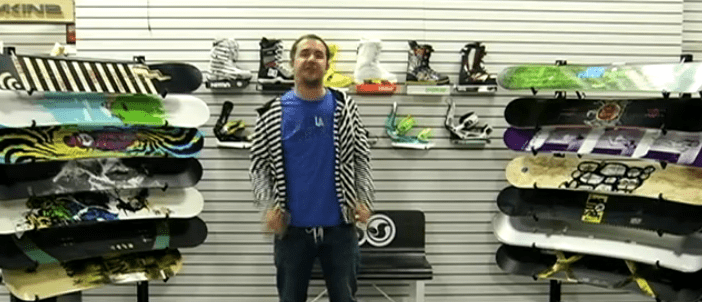


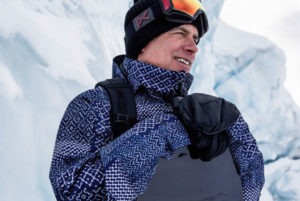

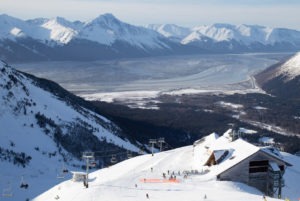
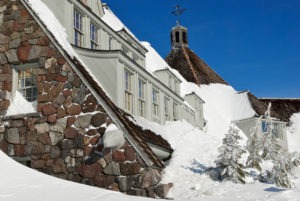
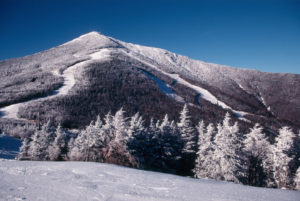
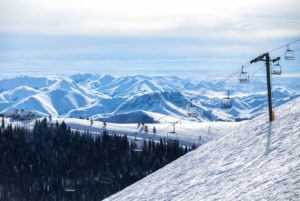
Hi there I liked reading your “how to buy a snowboard” so I thought I would turn to you for some advice. I have previously owned the Capita photo Fetish (every model actually) and loved them dearly but they don’t make them anymore. I know the mid life is similar but out of my price range. I go through at least a board or two or more a season so I don’t want to spend over $300. So having said that do you have any suggestions on a normal camber mid wideish 158-60 stiffer twin board with an aggressive “euro carve” sidecut? I am currently riding a DWD Keenan and the specs are perfect and it’s awesome for carving and bombing straight airs but is way too heavy and a bit too stiff to get technical if you know what I am sayin. So got any recommendations??
Thanks,
Jodan
[…] not only serve to protect them, but should help boost their confidence in using the board. See our How to Buy a Snowboard article for an in-depth view on all aspects of buying your first […]
This article is really helping. But I’m still trying to decide my skill level and what type of board I should get. I’ve gone snowboarding 3 times. The first time my friends said sink or swim so they skipped the bunny Hill and took me to a blue run something difficult. My friend helped me along and it honestly took us a good half hour to get half way down. However towards the second half I started to get it and felt more comfortable on the board. I stopped falling as much. It was awesome I loved it and my friend was really impressed. We went up again and I only fell like twice. After that I did like 4 runs on the bunny Hill trying out my heel and toe edge’s. I got really comfortable with going fast and I love just carving it’s awesome. By the end of the day I could kind of keep up with my friends further up the mountain. They told me I picked it up fast. The next two times were similar except I started out with the bunny Hill just to make sure I remembered how to do everything. After that it was all blue runs and it was sooo much fun!. Those times I rented a snowboard and they were some burton board size 160 wide. I felt comfortable with it. I’m about 5’11 and 200lbs size 11 feet. My dilemma is that I’m wanting to buy a snowboard instead of always having to rent. I’m in love with this sport and feel comfortable making the investment. However I just don’t know exactly what type of board to buy. I don’t want to buy a beginner board because I don’t do beginner runs. However I technically am a beginner. But what I want to do is buy a good pair of bindings and a good board that will last me years. So as I improve my skills I won’t have to buy a better board. I’ve been looking into the burton custom x wide paired with the burton mission bindings. I don’t know if that would be too much for me but then again I want to buy for the long run. Do you have any suggestions? Each time I go snowboarding I feel more and more comfortable going faster and carving all over the mountain. Thank you.
Check out the 159cm Burton Process Flying V Wide Snowboard HERE: https://www.the-house.com/9857btprfvwb16zz-burton-snowboards.html
[…] Choosing your first snowboard can be tough. You’ll most likely want a snowboard that is on the smaller side of your size range, this will give you more of an ability to maneuver the board. A twin-tip shape on a board will also assist in your learning because you will be centrally placed on the snowboard, providing you with the ability to ride both ways. Check out our snowboard buying guide on our website and if you already know what you want, be sure to check out our snowboarding gear over at this page here at The-House. […]
Thanks for posting the guidelines above. I’m just looking for an opinion on what to get. This will be my third season, and I really like to push my limits. I’m riding a 2019 K2 ray gun that I Bought from this site. I’ve maxed my speed out at 55mph and like going to the terrain park, but can only go straight of jumps, and I’ve only hit a few rails. I like speed, but also like riding in the park and want to improve on that. I’m 5’6” and weigh 115. What type of board or boards would you recommend. Preferably no more than $350
I would check out “all mountain” boards in the 150cm size range. Also look at boards with a medium to medium stiff flex for added stability at high speeds.